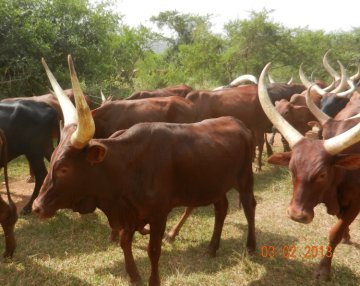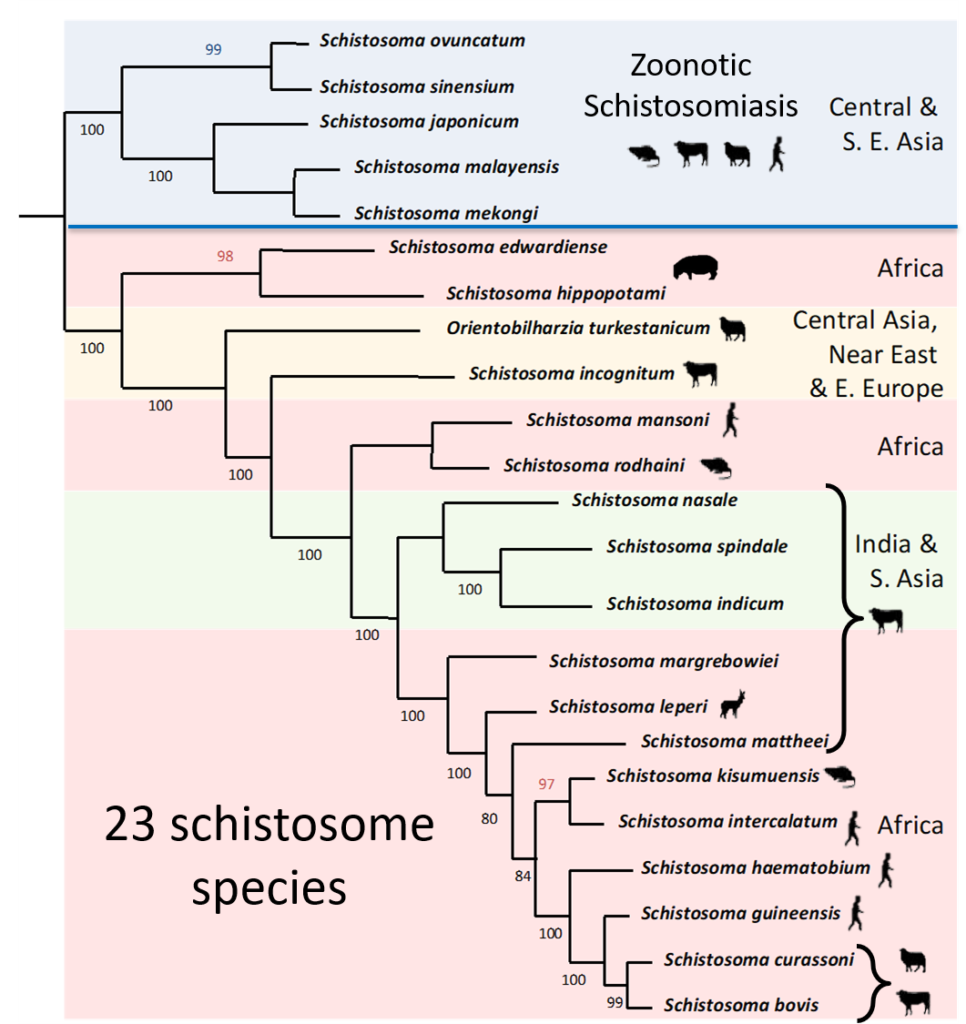Global Anticoccidial Drugs Market 2020 (Includes Business Impact of COVID-19) - Amazing Facts
Global Anticoccidial Drugs Market 2020 (Includes Business Impact of COVID-19) - Amazing Facts |
- Global Anticoccidial Drugs Market 2020 (Includes Business Impact of COVID-19) - Amazing Facts
- Bovines, Bilharzia and Benin: does Schistosoma hybridization happen in cattle? - BugBitten - BMC Blogs Network
- Antiparasitic treatment could help battle COVID-19 - www.thecattlesite.com
| Global Anticoccidial Drugs Market 2020 (Includes Business Impact of COVID-19) - Amazing Facts Posted: 29 Sep 2020 09:14 PM PDT  Trusted Business Insights answers what are the scenarios for growth and recovery and whether there will be any lasting structural impact from the unfolding crisis for the Anticoccidial Drugs Market market. Trusted Business Insights presents an updated and Latest Study on Anticoccidial Drugs Market Market 2020-2029. The report contains market predictions related to market size, revenue, production, CAGR, Consumption, gross margin, price, and other substantial factors. While emphasizing the key driving and restraining forces for this market, the report also offers a complete study of the future trends and developments of the market. The report further elaborates on the micro and macroeconomic aspects including the socio-political landscape that is anticipated to shape the demand of the Anticoccidial Drugs Market market during the forecast period (2020-2029). Get Sample Copy of this Report @ Global Anticoccidial Drugs Market 2020 (Includes Business Impact of COVID-19) Global Anticoccidial Drugs Market Analysis Trends, Applications, Analysis, Growth, and Forecast to 2029 is a recent report generated by Trusted Business Insights. The global anticoccidial drugs market report has been segmented on the basis of the type of animal, type of drug, and region. Request Covid – 19 Impact Global Anticoccidial Drugs Market: Overview Coccidiosis, a common cause of scours (diarrhea) in lambs and calves that is highly prevalent on cattle and sheep farms, is caused by protozoan parasites called Eimeria that multiply in the intestinal wall, transmitted from animal to animal by the fecal-oral route. Clinical signs include painful scours with or without blood, and decreased appetite and depression, which may progress to dehydration and weight loss. Coccidiosis primarily affects young animals; calves and lambs as young as three to four weeks of age may be affected. Coccidiosis causes significant economic loss to farmers and producers due to reduced feed conversion, reduced growth rates, reduced performance or death, and by increased susceptibility to other infections, such as intestinal disease or Bovine Respiratory Disease. Coccidiosis, caused by the parasites of the genus Eimeria which is one of the most severe poultry diseases worldwide. Coccidiosis is a type of common disease in animals caused by protozoan-type parasites namely coccidia. These parasites live as well as multiple in the intestinal tract and cause tissue damage in animals. Anticoccidial medications are used in conventional poultry production and commonly are added to poultry feed to prevent coccidiosis diseases. Coccidiosis is a type of parasitic disease and is the most important parasitic disease in poultry species such as pigs, rabbits, and cattle. Coccidiosis can cause a serious potential impact on animal health which may result in high mortality rates in animals. Global Anticoccidial Drugs Market: Dynamics Increasing demand for meat protein and rising need to protect poultry animals are some major key factor expected to drive the revenue growth of the target market over the forecast years. In addition, rising disposable income in developing countries, growing population, higher demand for diversified nutrition need, increasing consumption of meat, ready-to-eat meat products, frozen meats, and dairy products are some of the other factors expected to increase the demand for anticoccidial drugs globally. Furthermore, rising awareness among the global population regarding healthy and safe meat products is another factor expected to drive growth of the global anticoccidial drugs market. However, stringent government regulation is a major factor expected to hamper the growth of the target market to a significant extent. Global Anticoccidial Drugs Market: Segment Analysis Among the type of animal segments, the poultry is expected to register the highest market share in terms of revenue. This is primarily attributed to, shifting consumer preference toward more animal proteins. Among the type of drug segments, antibiotic anticoccidials are expected to witnessed highest market revenue share over the forecast period. Global Anticoccidial Drugs Market: Trends Major players are adopting key strategies such as acquisitions, joint ventures, and product launches by with a view to expanding the business. For instance, in March 2019, Creative Diagnostics launched a series of the innovative anticoccidial drug. Global Anticoccidial Drugs Market: Regional Analysis In 2019, the markets in North America is projected to a significant major share in the target market over the forecast period. This is primarily due to, growing demand for high-quality beef, improving the standard of living, rapid urbanization in countries in the region. The market in the Asia Pacific is projected to witness the highest CAGR over the forthcoming years. This is primarily to, growing livestock population and increasing demand for milk and dairy products which in turn is expected to support growth of the global anticoccidial drugs market in the Asia Pacific. Global Anticoccidial Drugs Market Segmentation: Segmentation by type of animal:
Segmentation by type of drug:
Key Industry Development: In Aug 2020, Merck Animal Health Completed the Acquisition of Worldwide Rights to VECOXAN® Brand of Parasiticides for Ruminant Portfolio. The acquisition Broadens Merck Animal Healths Position with Enhanced Parasite Protection in Calves and Lambs. Merck Animal Health, known as MSD Animal Health outside the United States and Canada, a division of Merck & Co., Inc., Kenilworth, N.J., USA (NYSE:MRK), today announced the completion of its previously announced acquisition of the worldwide rights to VECOXAN® (diclazuril), an oral suspension for the prevention of coccidiosis in calves and lambs, from Elanco Animal Health. VECOXAN is efficacious, in lambs, against the prevention of coccidiosis caused by Eimeria crandallis and Eimeria ovinoidalis, and in calves, against coccidiosis caused by Eimeria bovis and Eimeria zuernii. VECOXAN is available in Europe, South Africa, South Korea and Japan. Coccidiosis causes significant economic loss to farmers and producers due to reduced feed conversion, reduced growth rates, reduced performance or death, and by increased susceptibility to other infections, such as intestinal disease or Bovine Respiratory Disease. Elanco Animal Health Inc. agreed to sell the worldwide rights for Vecoxan to Merck & Co. Inc. unit Merck Animal Health for $55 million in an all-cash deal. Elanco is divesting the rights in a bid to address antitrust concerns regarding its $7.6 billion acquisition of Bayers animal health business, which is expected to close in mid-2020. The Vecoxan deal brings the total divestitures between $120 million and $140 million in revenue, which Elanco previously stated it would need to divest across both organizations to achieve any required clearances globally. In total, Elanco has generated about $425 million in pretax proceeds from the divestitures, and the company plans to use these funds to pay down debt associated with the Bayer animal health deal. Elanco has received antitrust clearance for the acquisition in China, Turkey and Ukraine. The company noted that it is in advanced discussions with the required regulatory authorities, which are progressing as expected. Vecoxan joins Elancos previously announced Osurnia® and Capstar® divestitures, and divestiture of European Economic Area and U.K. rights for Drontal® and Profender® from the Bayer portfolio. Looking for more? Check out our repository for all available reports on Anticoccidial Drugs Market in related sectors. Quick Read Table of Contents of this Report @ Global Anticoccidial Drugs Market 2020 (Includes Business Impact of COVID-19) ContactsTrusted Business Insights |
| Posted: 17 Jul 2020 12:00 AM PDT  taken by Hilary Hurd Schistosome species in Africa: blurring the lines! Schistosomes affect over 200 million people worldwide. Their impact as a parasitic disease on human health is huge, second only to malaria. However, their impact on other animals, particularly livestock, are also potentially devastating. Cattle schistosomiasis is estimated to affect 165 million domestic cattle worldwide, potentially causing anaemia, weight loss, growth retardation, organ damage and in severe cases death.  Unlike Schistosoma japonicum which is known to be zoonotic, it was traditionally believed that schistosome species in Africa were stricter with their definitive host species preference, particularly S. haematobium, considered to exclusively infect humans, and S. bovis, infecting only livestock. Furthermore, hybridization between different species of schistosomes, recorded in laboratory settings and occasionally reported in the field, was thought to be rare in nature due to the host preference of African schistosomes. However, recent findings using molecular techniques has thrown these assumptions in the air! Where does hybridization occur? Previous Bugbitten posts have highlighted the recent findings of hybrid schistosomes in human populations and there are projects underway to understand the geographical extent, epidemiological impact and genetic factors of schistosome hybrids and hybridization [Stothard et al 2020]. In a previous Bugbitten blog on the sex lives of schistosomes, Dr Bonnie Webster highlighted a key question: "Where are the adult worms of each species encountering each other?" S. bovis – S. haematobium hybrids have been found in human populations and in a rodent host in Senegal. However, until recently, there was little evidence on S. bovis in children, S. haematobium in cattle and S. bovis – S. haematobium hybrids in cattle.  Does schistosome hybridization occur in cattle? In a recent study by Savassi et al 2020, researchers investigated whether cattle in Benin are infected by S. bovis or S. haematobium and whether introgressive hybridization occurs. [For useful definitions see here, to find out more about hybridization and introgressive hybridization and the concept of species see here]. To do this they collected stool samples from cattle and stool and urine samples from school children in a village in Benin. The stool samples from cattle and children were filtered and eggs collected. Some of the eggs were preserved for an egg morphology study, the others were hatched and a subset of the larval stages (miracidia) were used for molecular analysis. For the cattle specimens, a subset of miracidia were used to infect two different species of snail intermediate hosts. The authors then monitored the snails for cercarial (schistosome larvae) emergence, to record the chronobiology of cercarial emergence, an ecological parameter related to the behavior of the preferred definitive host:
The authors preserved some of the emerging cercariae from each snail for molecular analysis. Ecological and taxonomic findings The molecular analysis confirmed previous findings that S. bovis – S. haematobium hybrids were present in humans in Benin. However, their research on the cattle samples were particularly interesting. The authors recorded the following 4 chronotypes based on the timing of cercarial emergence of the cattle-derived schistosomes from snails. The molecular analysis revealed interesting taxonomic groupings:
The egg morphology study revealed a high polymorphism in egg morphology from cattle and school children, with the greatest variation from cattle.
Main findings: this is the first evidence of S. bovis in Benin and the first evidence of introgressive hybridization between S. bovis and S. haematobium in cattle. This study also brought forward some very interesting information on the presence of differing chronobiological patterns of schistosome cercariae. Zoonosis and One Health This is the first evidence of S. haematobium and of S. bovis – S. haematobium hybrids in cattle. In the rural settings where schistosomiasis is prevalent, human and domestic animals live in close proximity. Cattle often roam freely in the areas surrounding villages and often use the same water sources. This is an ideal situation for schistosome infections and cross-species hybridization, potentially resulting in important consequences for public health measures to control and eliminate disease in humans and in cattle. More studies have looked at hybridization in Senegal, Niger, Cote D'Ivoire, Malawi and others. Some findings seem to indicate that hybridization is not a common phenomenon while others indicate that these are frequent. Understanding the frequency, ecology and epidemiology is crucially important to understand where zoonotic transmission and reservoir populations in cattle could hamper human disease control and elimination efforts [Stothard et al 2020]. A One Health approach to public health that encompasses strategies and methods for the control, prevention and surveillance of schistosome infections in domestic animals would contribute not only to the well-being of the domestic animals we rely on, but would also strengthen the efforts to eliminate human schistosomiasis and support food and economic security and sustainability. |
| Antiparasitic treatment could help battle COVID-19 - www.thecattlesite.com Posted: 06 Apr 2020 12:00 AM PDT News
Antiparasitic treatment could help battle COVID-1906 April 2020Emerging research has demonstrated that Ivermectin, a widely available antiparasitic treatment for cattle, inhibits the causative virus for COVID-19 (SARS-CoV-2) in vitro. Researchers at Monash University in Melbourne have shown that the antiparasitic drug Ivermectin can reduce and kill the SARS-CoV-2 virus, the causative agent of COVID-19, 48 hours after exposure. The trial demonstrated that a single dose of Ivermectin could stop SARS-CoV-2 growing in cell culture. Though this sounds promising, health authorities are warning people against self-medicating with Ivermectin as it could be fatal. The current research has not provided any information on appropriate dosage or delivery. Additional trials need to be carried out in humans before Ivermectin can be safely used. Dr Kylie Wagstaff, who led the study, explains, "We found that even a single dose could essentially remove all viral RNA by 48 hours and that even at 24 hours there was a really significant reduction in it. "…Although the mechanism by which Ivermectin works on the virus is not known, it is likely, based on its action in other viruses, that it works to stop the virus 'dampening down' the host cells' ability to clear it." Using Ivermectin to combat COVID-19 depends on the results of additional pre-clinical tests and clinical trials. Dr Wagstaff says that funding is urgently needed to continue research. BackgroundIvermectin is a common veterinary drug, killing a wide range of internal and external parasites in livestock and companion animals. The drug is also used in human medicine to treat other parasitic infections like headlice and river blindness. Since Ivermectin included on the WHO model list of essential medicines, it is widely available and is an excellent candidate for re-purposing for other treatments. Researchers have shown that the drug has strong anti-viral potential in in vitro trials – targeting both DNA-based and RNA-based viruses and inhibiting their replication. However, this in vitro efficacy hasn't always translated in human trials. Read the original abstract here. |
| You are subscribed to email updates from "common parasitic diseases in cattle" - Google News. To stop receiving these emails, you may unsubscribe now. | Email delivery powered by Google |
| Google, 1600 Amphitheatre Parkway, Mountain View, CA 94043, United States | |
Comments
Post a Comment